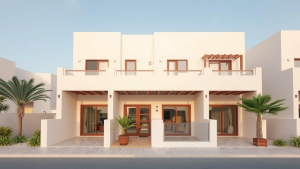What to expect during environmental impact assessments in al kawther: key processes and stakeholder roles
Environmental impact assessments (EIAs) in Al Kawther represent a critical process aimed at evaluating the potential environmental effects of proposed projects or developments. Understanding what to expect during these assessments can help you navigate the complexities involved effectively. Different phases of the EIA process engage various stakeholders, each playing a vital role in shaping the final decision.
Stage one: preparation and scoping
The first stage of an EIA involves preparation and scoping. During this phase, project developers identify key issues related to environmental impacts. You can expect to see:
- Identification of Stakeholders: Initial identification of individuals and organizations that may be affected by the proposed project.
- Public Consultation: Developers will often hold meetings to gather input from the community regarding potential concerns.
- Defining Scope: The assessment’s scope is outlined, detailing what environmental aspects will be addressed in the study.
Stage two: baseline studies
After establishing the scope, baseline studies take place. This involves collecting data on the current environmental conditions in Al Kawther. You may find studies examining:
- Aquatic and Terrestrial Ecosystems: Surveys of local wildlife and plants to understand biodiversity.
- Air and Water Quality: Tests to monitor current levels of pollution.
- Community Health Assessments: Evaluating how current environmental factors impact the local population’s health.
Public involvement during this stage is also crucial as it fosters transparency and trust between developers and the community.
Stage three: impact assessment
The third phase is the heart of the EIA process: the actual impact assessment. During this crucial stage, stakeholders should expect:
- Predictive Models: Utilizing models to predict how proposed changes may affect environmental resources.
- Significance Assessments: Evaluating the magnitude of potential effects, ranging from negligible to substantial impacts.
- Mitigation Strategies: Identifying methods to avoid or minimize adverse impacts.
Stage four: drafting the eia report
Upon completing the impact assessments, developers compile their findings into a draft EIA report. This document should clearly outline:
- Methodologies Used: A description of how data was collected and analyzed.
- Key Findings: A summary of the likely environmental impacts identified in the assessment.
- Mitigation Measures: Detailed strategies to reduce negative environmental effects.
Transparency is paramount during this stage. Engaging stakeholders with preliminary findings fosters constructive dialogue and feedback.
Stage five: review and finalization
The review stage is where the EIA report undergoes final evaluations. Key components of this process include:
- Government Review: Relevant government departments assess the report for compliance with environmental regulations.
- Public Comment Period: A time for community members to submit their feedback on the draft report.
- Final EIA Approval: Once any concerns have been addressed, authorities will give final approval or require additional modifications.
Stakeholder engagement
Throughout the entire EIA process, the engagement of stakeholders is crucial. Different groups involved include:
- Government Agencies: They oversee the EIA process and ensure compliance with national and local regulations.
- Community Members: Local residents who can provide valuable insights and perspectives on the potential impacts of the proposed project.
- Environmental Organizations: Groups that advocate for environmental protection and may get involved in reviewing EIA processes to ensure adherence to best practices.
Understanding the EIA process in Al Kawther equips you with the knowledge you need to participate effectively. From the initial preparation and scoping to stakeholder engagement, each stage plays a critical role in ensuring sustainable development while safeguarding the environment. By actively engaging, you can contribute to outcomes that promote both community well-being and ecological integrity.
The importance of community involvement in environmental impact assessments in al kawther
Community involvement plays a crucial role in environmental impact assessments (EIAs) in Al Kawther. Engaging local residents ensures that the assessment reflects their values, knowledge, and concerns about the environment. This participation is not just a formality; it’s essential for effective decision-making and sustainable development.
When residents of Al Kawther actively take part in the EIA process, several benefits emerge. First, they offer valuable insights about local ecology and the socio-economic environment. A community knows its surroundings better than anyone else, including the unique flora and fauna, cultural significance of areas, and existing land-use practices. By sharing these insights, the community can influence project plans to minimize adverse effects on their environment.
Another important aspect of community involvement is transparency. When residents feel included in the EIA process, they are more likely to trust the decisions made by developers and government. This trust builds a collaborative relationship and enables assurance that any impacts will be effectively managed. Open communication fosters an environment where concerns can be raised and addressed promptly, ensuring that all voices are heard.
Participation also promotes accountability among project developers. When local residents are part of the process, developers are held to higher standards. They must present accurate information and be prepared to justify their plans. Misleading information or neglecting environmental impacts is less likely to occur when the community serves as a watchdog, ready to question and challenge any shortcomings.
Furthermore, community involvement in EIAs can lead to more culturally and environmentally relevant project outcomes. Local residents might suggest alternatives that could achieve similar goals without damaging essential resources. For instance, if a proposed project risks disrupting a natural habitat, a community member might propose route changes that spare these areas. This creative input can result in innovative solutions that benefit both developers and the environment.
During assessments in Al Kawther, several steps facilitate community involvement:
- Public Meetings: These gatherings allow residents to voice their opinions, ask questions, and provide feedback. They serve as a platform for dialogue between project developers and the community.
- Workshops: Educational workshops can enhance community understanding of the EIA process and the potential impacts of proposed projects. Knowledge empowers residents to articulate their concerns effectively.
- Surveys and Questionnaires: Collecting structured input through surveys can help gauge public sentiment and identify specific issues to address in the impact assessment.
- Advisory Committees: Forming committees that include community representatives can ensure ongoing dialogue and provide a formal channel for feedback and suggestions.
Active participation in the EIA process also enhances community pride and ownership. When people see their input reflected in project plans, they are more likely to engage in protecting their environment. This sense of responsibility fosters a culture where sustainability is embraced and communities come together to advocate for environmental stewardship.
Moreover, including the community in environmental reviews can improve the overall quality of the assessments. A diverse set of perspectives can reveal unforeseen issues or alternatives that specialists might overlook. In Al Kawther, the community’s unique relationship with the land can offer invaluable data that enriches the assessment process.
Importantly, community involvement nurtures resilience. With active participation, local residents become adept at navigating environmental changes and potential disruptions. They develop a stronger connection to their surroundings, equipping them with the tools to advocate for their needs and protect their environment in the future.
In the dynamic context of Al Kawther, fostering community involvement during environmental impact assessments is a pathway to responsible development. By valuing local perspectives, ensuring transparency, and promoting accountability, the community can significantly influence project outcomes. Their involvement not only leads to better decision-making but also cultivates a healthier environment for generations to come. Empowering communities to take an active role will be vital in shaping sustainable futures in this rapidly changing world.
Understanding what to expect during environmental impact assessments in Al Kawther is crucial for everyone involved. The processes involved, including data collection, analysis, and reporting, set the foundation for responsible development. Engaging stakeholders, from local community members to government agencies, ensures diverse perspectives are considered, which enhances the quality of the assessment. Each participant plays a key role, making the voices heard throughout the process essential for transparent outcomes.
Equally important is the involvement of the Al Kawther community itself. When residents actively participate, they can share valuable insights regarding local environmental concerns, cultural heritage, and community needs. This grassroots involvement fosters a sense of ownership and accountability, resulting in environmentally sustainable decisions that reflect the community’s values and priorities.
Ultimately, the effectiveness of environmental impact assessments hinges on a collaborative approach. By understanding the key processes and embracing community involvement, Al Kawther can pave the way for projects that not only meet development goals but also protect and preserve the environment for future generations. Engaging fully in this process empowers individuals and strengthens the bond within the community, creating a shared responsibility for environmental stewardship. As you navigate this landscape, remember that your voice and participation are vital components in shaping a sustainable future for Al Kawther.
Last offer – 5 bedroom penthouses with balconies in Al Ahyaa Hurghada under 200k — luxury homes for british digital nomads
16% off – modern 1 bedroom duplex apartments in makadi Hurghada under 50k — spacious living for british traders












